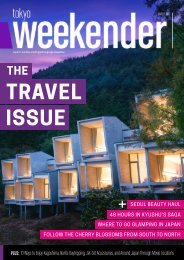Tokyo Weekender - November 2017
Our November issue is out, featuring a jam-packed end-of-year special: 42 Christmas gift shopping ideas and 10 bonenkai spots. Plus: The avant-garde world of butoh dance, Japanese teen prodigies, and a special supplement guide to Akita. Here's where to find a copy around Tokyo: www.tokyoweekender.com/pickup/
Our November issue is out, featuring a jam-packed end-of-year special: 42 Christmas gift shopping ideas and 10 bonenkai spots. Plus: The avant-garde world of butoh dance, Japanese teen prodigies, and a special supplement guide to Akita. Here's where to find a copy around Tokyo: www.tokyoweekender.com/pickup/
Create successful ePaper yourself
Turn your PDF publications into a flip-book with our unique Google optimized e-Paper software.
TOP THINGS<br />
TO DO, SEE,<br />
AND EAT<br />
IN TOHOKU<br />
The 2011 earthquake and tsunami left the Tohoku region devastated,<br />
but far from beaten. If you’re planning a visit to the area, check out<br />
our guide to exploring and dining (including halal options), as well<br />
as places to reflect on the effects of the disaster<br />
Words by Matthew Hernon<br />
While there is still much to do to<br />
aid the recovery effort in the<br />
north-eastern portion of Honshu,<br />
remarkable progress has<br />
been made over the past six and a half years,<br />
particularly in the worst hit prefectures of<br />
Fukushima, Miyagi and Iwate.<br />
Tourism in Tohoku – which also includes<br />
Aomori, Akita and Yamagata (these prefectures<br />
suffered only minor damage from the<br />
disaster, but have continued to provide support<br />
for their neighbors in Tohoku) – suffered<br />
as a result of the disaster, but has seen an<br />
increase in the number of visitors to the<br />
area since 2015. Despite this, it remains one<br />
of the most underrated areas in all of Japan,<br />
boasting natural wonders, rustic hot spring<br />
towns, lively festivals, all kinds of culinary<br />
delights and so much more.<br />
Here, we round up some of the top<br />
activities and sights in the different prefectures,<br />
while being mindful of recovery<br />
efforts. Over the page, we gather together<br />
some of our favorite eats, and offer a guide<br />
for those looking for halal foods and<br />
Muslim-friendly facilities.<br />
TOP THINGS<br />
TO DO<br />
MIYAGI<br />
Disposing of the staggering 15.6 million tons<br />
of debris was just one of the herculean tasks<br />
Miyagi citizens faced following the tragedy<br />
in 2011. The fishing town of Ishinomaki<br />
alone was burdened with around 6.2 million<br />
tons. Though the rubble has since been<br />
cleared, the affected coastal areas remain<br />
barren. Looking out over the waterfront from<br />
the hilltop park of Hiyoriyama provides a<br />
stark reminder of the destruction. There are<br />
guided tours around disaster areas to help<br />
raise awareness of tsunami preparedness and<br />
at Oginohama Elementary School you can<br />
see the works of artist Parco Kinoshita who's<br />
carving thousands of mini wooden statues in<br />
honor of those killed on March 11.<br />
It's a day that locals will never forget, but<br />
they are determined to push forward and<br />
encourage more visitors to the area. A tour<br />
from Ishinomaki to the islands of Tashirojima<br />
(pictured left) and Matsushima is particularly<br />
popular. The former is home to more cats<br />
than people, while the latter is considered<br />
one of the three great scenic spots of Japan.<br />
Taking a dip in an open-air bath overlooking<br />
Matsushima Bay is highly recommended.<br />
It's also worth spending time in the "City of<br />
Trees" that is Sendai, especially during the<br />
Aoba Festival in May, which commemorates<br />
the death of Daimyo Date Masamune.<br />
IWATE<br />
The second largest prefecture in Japan, Iwate<br />
was severely damaged as a result of the<br />
earthquake and tsunami. One of the worst hit<br />
areas was Rikuzentakata, a coastal city that's<br />
become an international symbol of resilience<br />
and reclamation. A 250-year-old miracle<br />
pine tree, the only one among 70,000 trees<br />
left standing after the devastation (it was<br />
preserved using a rod and synthetic branches<br />
when salt water destroyed its roots in 2012),<br />
attracts busloads of tourists and there are<br />
opportunities to work with local farmers,<br />
fishermen and craftspeople as part of the<br />
Marugoto Rikuzentakata Project.<br />
When it comes to natural wealth, few<br />
prefectures are as rich as Iwate. A boat ride<br />
44 | NOVEMBER <strong>2017</strong> | TOKYO WEEKENDER
















